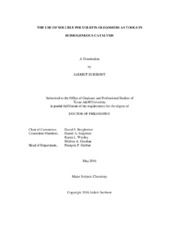| dc.description.abstract | Soluble polyolefins such as polyethylene (PEOlig) and polyisobutylene (PIB) are useful tools in catalysis. This dissertation describes several examples that these polyolefins were used to facilitate homogeneous catalysis reactions. This include the use of PEOlig as protective encapsulating agent toward acid-promoted demetalation of metal-salen complexes, the use of PEOlig as a cosolvent and catalyst support in ring-opening metathesis polymerization (ROMP), the use of PIB as a post-reaction Ru removal tool in olefin metathesis, and the use of PIB as a support for a pyridine ligand on Ru(II) catalyst for ring-opening metathesis polymerization (ROMP).
The stability of polyethylene oligomer (PEOlig)-entrapped salen-metal complexes toward acidolysis was tested by suspending these species in acidic methanol for 24 h at 25°C. The lack of metal leaching due to acid-promoted demetalation was determined using both colorimetric and ICP-MS analyses. These results were in contrast to the reported behavior of low molecular weight salen metal complexes and to results seen with a salen complex bound to divinylbenzene (DVB) crosslinked polystyrene that demetalates under acidic conditions at room temperature.
Polyethylene oligomers (PEOlig) were also used as a cosolvent and soluble catalyst support in ring-opening metathesis polymerization (ROMP) reactions. As a catalyst support, this polyolefin serves as an N-heterocyclic carbene ligand for a ROMP catalyst, making it soluble at 70°C and insoluble at room temperature. As a cosolvent, unfunctionalized PE oligomers facilitate quantitative separation of PEOlig-bound Ru- catalyst residues from polymer products resulting in ROMP products with Ru contamination lower than other procedures that use soluble catalysts.
Polyisobutylene (PIB) -terminated isocyanide was prepared in two steps under mild condition with high yield. Using this reagent, the RCM product of N,N-diallyl-4-methylbenzenesulfonamide could be prepared with ruthenium content as low as 44 ppm without involving purification with silica gel. However, this protocol was unsuccessful in sequestering Ru species from ROMP reaction due to an insufficient reactivity of PIB-terminated isocyanide.
At the end, this dissertation details the use of PIB as a support for a pyridine ligand on Grubbs third generation catalyst for ROMP reactions. Using the Grubbs third generation catalyst ligated by PIB-bound pyridines does not affect the reactivity of these catalysts in ROMP chemistry. However, the Ru complexes that employ PIB-bound pyridines can prepare polymer products with significantly lower Ru contamination than those prepared with Ru complex with low molecular weight pyridines. Further increasing the non-polar character of Ru catalyst can reduce Ru leaching by ca. 60%. | en |


